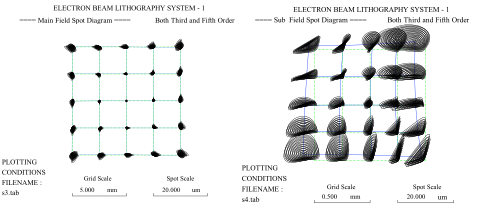ABER-5: Computing Fifth-Order Aberrations
This software package is supplied as an upgrade to the OPTICS and SOFEM packages. It extends the capabilities of the OPTICS package to compute the higher-order aberrations of complete electron and ion beam columns, as well as the primary aberrations. ABER-5 computes all the same aberrations as OPTICS - i.e. the third-order geometrical and first-order chromatic aberrations, and in addition it computes the fifth-order geometrical and third-order chromatic aberrations. The accurate prediction of these higher-order aberrations is important in designing electron and ion beam systems which use large-area projection or large-field scanning. Such systems are required for high-throughput lithography applications.

The software computes the higher-order aberrations using specially derived aberration integrals. The axial field functions of the lenses and deflectors are first obtained with the SOFEM package. The radial expansions of these field functions, up to fifth-order terms in the off-axis distance, are then obtained by taking several axial derivatives of each axial field function. The high accuracy inherent in the fields computed with the SOFEM software is essential for obtaining accurate values of the high-order derivatives of the axial field functions. For example, for a dual-channel deflection system (with main-field and sub-field deflection), there are 124 complex fifth-order geometrical aberration coefficients in the case of a point source, and 380 for a shaped beam system. All chromatic coefficients up to third order are also computed. The results are output in tabular form, and also graphically in the form of distortion diagrams and aberration spot diagrams.
If you are interested in the ABER-5 package, please contact us at info@electronoptica.com.

